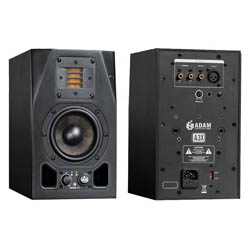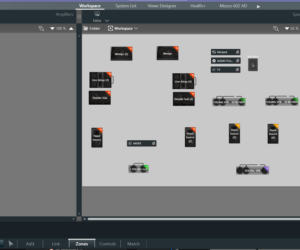
With the launch of the new AX Series, which replaced the previous budget A Series, ADAM extended its range adding two new speaker sizes: the big A8X with an 8.5” woofer and the small A3X.
Considering the very affordable price of the speaker (less than $300 on the street) the question has arisen of whether the A3X is worthy of its family or not. So, we decide to have a closer look…
We were surprised by the size of the speaker when we unpacked it. With its extremely compact dimensions (10” x 6” x 7.5”), the A3X can find a place in many small studios.
However, it’s slightly bigger than another speaker often discussed in this size, the Focal CMS 40.
On the other hand, it is a bit lighter, which will be an advantage for mobile home studio owners with fragile shoulders. Its design is no surprise, the speaker looks like all its bigger brothers: anthracite finish, two bass reflex ports, woofer without protection grill, and the famous X-ART ribbon tweeter.
It’s the ADAM mini-me!
The manufacturing quality is flawless and the speaker seems quite rugged. However, you’ll have to protect the woofer during transportation because it has no protective grill. For the lows it uses a 4.5” carbon fiber woofer, unlike the A5/7/8X that use carbon/Rohacell/glass fiber low-frequency drivers.
On the other hand, the ribbon tweeter seems to be exactly the same as the high-frequency drivers used on the other speakers in the series, which is very good news.
Inside the speaker cabinet you’ll find two 25-watt (RMS) A/B amplifiers. The speaker is not magnetically shielded so beware if you still use an old CRT monitor.
The power switch is on the front panel (far more practical than on the rear), as well as the volume control. You can link the volume control of the two speakers so that you can set the volume of both with only one control. Very useful.
On the rear panel you’ll find a balanced XLR input plus an unbalanced RCA input – no 1/4” TRS jacks. The settings allow adjustment of tweeter gain (-/+4dB) and nothing more.
The A3X provides no additional acoustic adjustment possibilities, which would come in very handy. The very low price of the speaker obviously has an impact on some details, like this one: don’t expect miracles!
The crossover frequency is set at 2.8 kHz and the input accepts signal levels up to +14dB (input sensitivity).
Obviously the monitors are capable, but how do they fare when giving them a listen?















